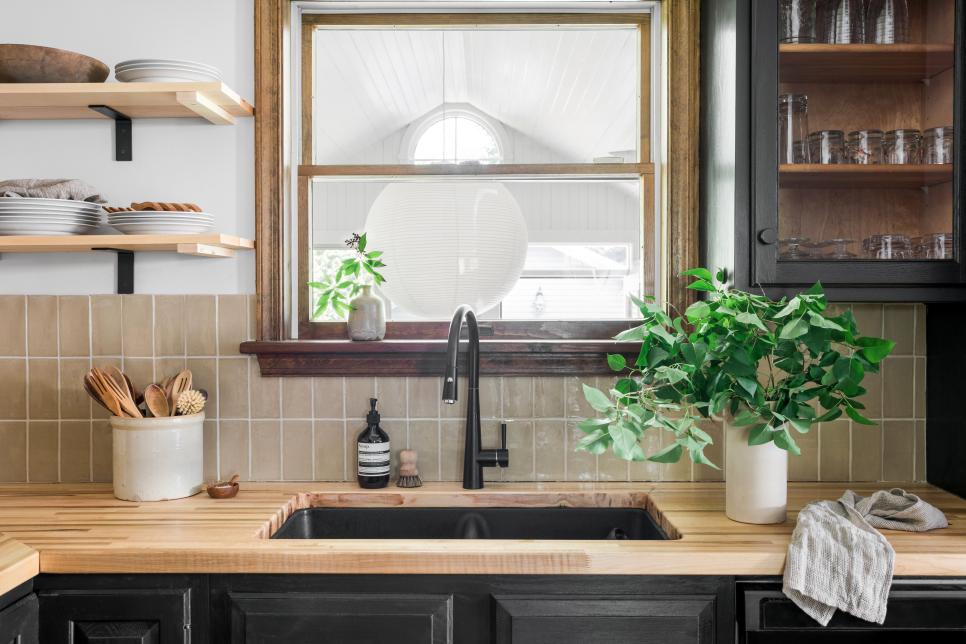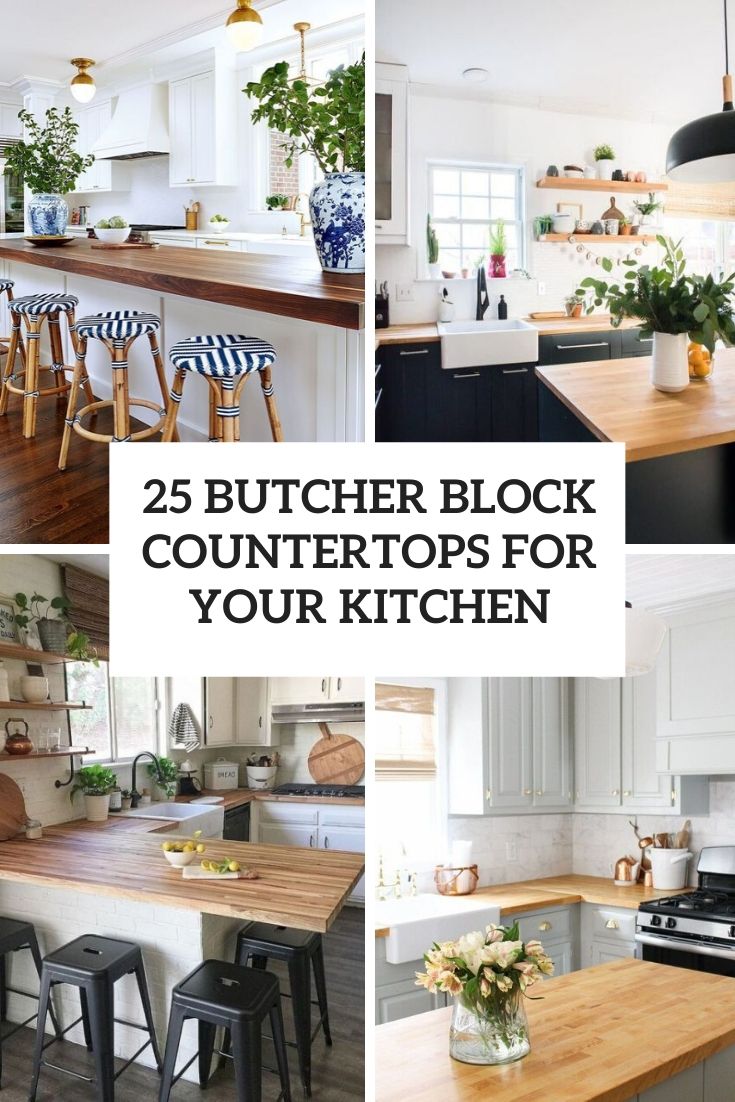When designing a kitchen with butcher block countertops, there are several factors to consider that can enhance the overall aesthetic and functionality of the space. Butcher block countertops are made from straight cuts of wood, often glued together to create a sturdy, solid surface. They add warmth and natural beauty to any kitchen, making them a popular choice for both traditional and modern designs.
One of the first decisions to make when incorporating butcher block countertops into your kitchen design is the type of wood to use. Hardwoods such as maple, oak, walnut, and cherry are common choices due to their durability and attractive grain patterns. Each type of wood has its unique color and character, which can significantly impact the overall look of your kitchen. Maple, for instance, is light and smooth, offering a clean, bright appearance, while walnut is darker and richer, adding depth and sophistication.
The finish of your butcher block countertops is another crucial consideration. There are several options available, including mineral oil, polyurethane, and varnish. Mineral oil is a food-safe, natural option that penetrates the wood and enhances its natural beauty. It requires regular reapplication to maintain its protective properties. Polyurethane and varnish provide a more durable, waterproof finish but may not be food-safe for direct contact. Deciding on the right finish depends on how you intend to use your countertops and your maintenance preferences.
Butcher block countertops can be integrated into various kitchen styles, from rustic farmhouses to sleek contemporary designs. In a farmhouse kitchen, for example, the warm, natural look of butcher block countertops pairs beautifully with white or cream cabinetry, vintage fixtures, and open shelving. Adding a large farmhouse sink and distressed wood elements can further enhance the cozy, lived-in feel of the space.

For a more modern kitchen, consider pairing butcher block countertops with sleek, minimalist cabinetry and stainless steel appliances. The contrast between the warm wood and the cool, industrial elements creates a balanced, visually appealing look. You can also incorporate bold colors and high-gloss finishes to add a touch of contemporary flair.
Incorporating an island with a butcher block countertop can be a practical and stylish addition to your kitchen. An island provides additional workspace, storage, and seating, making it a versatile centerpiece. The butcher block surface is ideal for food preparation and can double as a casual dining area. Consider adding pendant lighting above the island to highlight the natural beauty of the wood and create a focal point in the room.
Open shelving is another design element that complements butcher block countertops. The open shelves can be used to display dishes, glassware, and decorative items, adding a personal touch to your kitchen. The natural wood of the shelves can tie in with the countertops, creating a cohesive and harmonious look.

Backsplashes play a significant role in kitchen design, and choosing the right backsplash to pair with butcher block countertops is essential. White subway tiles are a classic choice that complements the warm tones of the wood, creating a timeless and elegant look. For a more rustic feel, consider a brick or stone backsplash, which adds texture and visual interest.
Lighting is a critical component of any kitchen design. Proper lighting can enhance the appearance of your butcher block countertops and create a welcoming atmosphere. Under-cabinet lighting can highlight the countertops and provide task lighting for food preparation. Pendant lights and chandeliers can add a decorative element while ensuring the space is well-lit.
When it comes to kitchen layout, the versatility of butcher block countertops allows them to be incorporated into various configurations. L-shaped, U-shaped, and galley kitchens can all benefit from the warmth and functionality of butcher block surfaces. The layout you choose will depend on the size and shape of your kitchen, as well as your cooking and entertaining needs.
Storage solutions are essential in a well-designed kitchen. Custom cabinetry with built-in organizers, pull-out drawers, and pantry space can maximize efficiency and keep your kitchen clutter-free. The natural wood of butcher block countertops can be complemented by cabinetry in a coordinating wood tone or a contrasting color for added visual interest.
Appliances also play a crucial role in kitchen design. Stainless steel appliances are a popular choice for their durability and modern appearance. They pair well with the warm tones of butcher block countertops, creating a balanced and stylish look. Alternatively, white or black appliances can create a more cohesive and streamlined appearance.

Flooring is another important consideration in kitchen design. Hardwood floors can complement butcher block countertops, creating a warm and cohesive look. For a more durable and low-maintenance option, consider tile or luxury vinyl flooring in a wood-look finish. The key is to choose flooring that coordinates with the overall design and enhances the natural beauty of the wood countertops.
Accessories and decor can add the finishing touches to your kitchen design. Consider incorporating elements such as a wooden cutting board, a fruit bowl, or potted herbs to enhance the natural, organic feel of the space. Textiles such as dish towels, rugs, and window treatments can add color and texture, tying the design together.
The functionality of butcher block countertops extends beyond aesthetics. They provide a durable and forgiving surface for food preparation, making them ideal for avid home cooks. The wood surface is gentle on knife blades, reducing wear and tear on your kitchen tools. Additionally, minor scratches and dents can be easily sanded out, allowing the countertops to maintain their beauty over time.
Regular maintenance is essential to keep butcher block countertops looking their best. Cleaning the surface with a mild soap and water solution and promptly wiping up spills can prevent stains and water damage. Periodic oiling or refinishing, depending on the finish you choose, will help protect the wood and enhance its natural beauty. With proper care, butcher block countertops can last for many years and continue to add warmth and character to your kitchen.

Common Mistakes to Avoid
One common mistake when designing a kitchen with butcher block countertops is neglecting to consider the maintenance requirements. While butcher block countertops are beautiful and durable, they require regular care to prevent stains, scratches, and water damage. Failing to properly maintain the countertops can lead to unsightly wear and tear, detracting from the overall appearance of your kitchen.
Another mistake is choosing the wrong type of wood or finish for your countertops. Different woods have varying levels of hardness and durability, and selecting a softer wood may result in more frequent dents and scratches. Additionally, some finishes are not food-safe and may not be suitable for direct contact with food. It’s important to research and choose the right wood and finish for your specific needs and preferences.
Improper installation can also lead to issues with butcher block countertops. Ensuring that the countertops are properly sealed and installed is crucial to prevent water damage and warping. If you’re not confident in your ability to install the countertops correctly, consider hiring a professional to ensure a seamless and durable result.
Another common oversight is not considering the overall design and layout of the kitchen. Butcher block countertops should complement the cabinetry, flooring, and other design elements in the space. Failing to create a cohesive design can result in a disjointed and unappealing kitchen.

How do I maintain and care for butcher block countertops?
Maintaining butcher block countertops involves regular cleaning and periodic oiling or refinishing, depending on the finish used. Clean the surface with a mild soap and water solution, and promptly wipe up spills to prevent stains and water damage. If your countertops are finished with mineral oil, apply a fresh coat of oil every few months to keep the wood hydrated and protected. For polyurethane or varnish finishes, clean with a damp cloth and avoid abrasive cleaners. Sand out minor scratches and dents as needed to maintain the countertops’ appearance.
Are butcher block countertops durable enough for daily use?
Yes, butcher block countertops are durable and can withstand daily use, making them ideal for kitchen environments. Hardwoods such as maple, oak, and walnut are particularly durable and resistant to wear and tear. However, it’s important to properly maintain the countertops to prevent scratches, stains, and water damage. Using cutting boards, and trivets, and promptly cleaning up spills can help prolong the life and appearance of butcher block countertops.
Can I use butcher block countertops in a modern kitchen design?
Absolutely! Butcher block countertops can be incorporated into various kitchen styles, including modern designs. Pairing the warm, natural wood with sleek, minimalist cabinetry and stainless steel appliances creates a balanced and visually appealing look. You can also incorporate bold colors, high-gloss finishes, and modern lighting fixtures to add a contemporary flair. The versatility of butcher block countertops makes them suitable for both traditional and modern kitchens.

How do I choose the right wood for my butcher block countertops?
Choosing the right wood involves considering factors such as hardness, color, and grain pattern. Hardwoods like maple, oak, walnut, and cherry are popular choices due to their durability and attractive appearance. Maple is light and smooth, offering a clean, bright look, while walnut is darker and richer, adding depth and sophistication. Oak and cherry offer unique grain patterns and warm tones. Consider your kitchen’s overall design and your personal preferences when selecting the wood type.
Can I install butcher block countertops myself?
Installing butcher block countertops can be a DIY project if you have the necessary skills and tools. However, it requires precise measurements, proper sealing, and careful installation to ensure a durable and seamless result. If you’re not confident in your ability to achieve a professional-looking installation, consider hiring a professional. Proper installation is crucial to prevent issues such as water damage, warping, and uneven surfaces.
What are the pros and cons of butcher block countertops?
The pros of butcher block countertops include their natural beauty, warmth, and durability. They provide a forgiving surface for food preparation and are gentle on knife blades. Minor scratches and dents can be sanded out, and with proper care, butcher block countertops can last for many years. The cons include the need for regular maintenance, such as oiling and refinishing, and the potential for stains and water damage if not properly maintained. Additionally, butcher block countertops can be more susceptible to scratches and dents compared to harder countertop materials like granite or quartz.

Kitchens with Butcher Block Countertops Sebring Design Build

Kitchens with Butcher Block Countertops Sebring Design Build

Related articles:
- Thick Butcher Block Countertop
- How To Finish A Butcher Block Countertop
- Butcher Block Countertops Sealing
- Butcher Block Countertops Redo
- Dark Stained Butcher Block Countertops
- Staining Butcher Block Countertops
- Butcher Block Countertops Mineral Oil
- How To Finish Butcher Block Countertops
- Pine Butcher Block Countertops
- Used Butcher Block Countertops